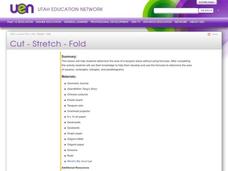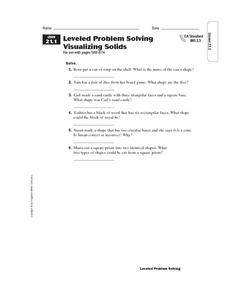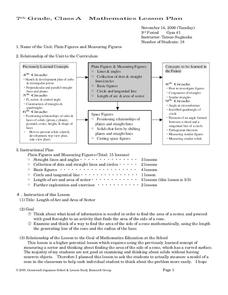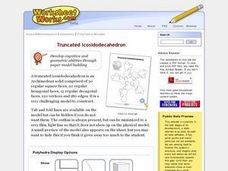Curated OER
Plane Figures
Fifth graders create polygons requested by their teacher. In this polygons lesson, 5th graders watch a video and listen to a song about polygons. Then, students take turns labeling various polygons and practice making polygons.
Curated OER
Geometry Project
Proofs are usually an intimidating assignment. An engaging lesson focused on geometric proofs may reduce the anxiety! Pupils choose between several triangle proofs to complete and work on completing them. The...
MENSA Education & Research Foundation
Shapes - Kindergarten
Extend scholars' learning experience with a unit consisting of five shape lesson plans, an extension activity, assessment, and rubric. Begin by reading a story about shapes, then conduct an overview and assign pupils' their first...
Curated OER
Three Dimensional Boxes
Students investigate the geometric shape of a box. They apply different construction methods and materials to create a three dimensional box. The uses of a box are covered and the measurements taken to consider its uses. Students...
Balanced Assessment
Dart Boards
Bulls eye! Design dart boards with specific chances of winning. Individuals determine the probability of hitting a circular and a triangular dart board inscribed in squares. They create dart boards that have a 50 percent chance of...
Virginia Department of Education
Constructions
Pupils learn the steps for basic constructions using a straightedge, a compass, and a pencil. Pairs develop the skills to copy a segment and an angle, bisect a segment and an angle, and construct parallel and perpendicular lines.
Curated OER
Area of Tangram Pieces
Mathematicians calculate the area of a tangram piece without using formulas. They use a geometry journal to record activities during this lesson. They make a set of tangrams and use them to compute area. They use...
Curated OER
Children's Museum of Houston - Pre/Post Classroom Activities - Nets
Students make three dimensional shapes with nets. For this nets lesson, students receive nets which they fold to make a three dimensional object. They predict what shape each net will make and verify it after making the net. They use the...
Curated OER
Count on Me
Fourth graders use inductive reasoning to find algebraic patterns in geometric figures. They use technology (i.e., calculators, computers) and manipulatives to discover number patterns involving geometric concepts. They solve concrete...
Curated OER
Leveled Problem Solving: Visualizing Solids
Connecting academic concepts to real-life applications is an important component of any lesson, especially with such topics as geometric shapes. In this worksheet on geometric shapes, students answer word problems. This worksheet could...
Curated OER
Investigation-On the Surface
Students compute the surface area of 3 geometric solids to determine the shape of package that would require the least amount of paper to wrap. In this geometry lesson, students work on a two-question assessment embedded in the plan. The...
Curated OER
Plain Figures and Measuring Figures
Students investigate basic geometric concepts. In this geometry lesson, students explore solids through measuring and modeling. This assignment models the importance of understanding concrete objects in geometry.
Curated OER
Blocks in a Sock
First graders identify geometric solids. In this shapes and solids beginning geometry lesson, 1st graders reach into a bag and identify the geometric solid they feel. Students describe shape attributes and match two dimensional shapes to...
Curated OER
Nature's Polyhedrons
Students are introduced to polyhedrons through using straw models to explore geometric solids and constructing Christmas tree ornaments using Epsom salt crystals. Students will view interactive videos and investigate and retrieve...
Curated OER
Perimeter, Circumference, Volume, and Surface Area
In this Perimeter, Circumference, Volume, and Surface Area worksheet, students are asked to identify geometric formulas and calculate for volume and surface area for geometric solids. In addition, students are asked to identify...
Curated OER
Space and Shape in Geometry:
Students are asked to visualize three-dimensional figures and apply this visualization to problem solving.
Curated OER
Names of figures
In this shapes learning exercise, learners pick the correct names of the 2D shapes, and pick out the correct 2D shape. Students complete 4 problems total.
Curated OER
Shape Tool
Students explore various polygons and examine how shapes can be manipulated in a variety of ways. In this shape tool lesson, students identify geometric shapes in two dimensions. Students identify and draw one line of symmetry in a...
Curated OER
2-D Geometry
Third graders describe and compare attributes of two-dimensional shapes. They explain geometric terms, angles and shapes. Students demonstrate each vocabulary word with their body and they mirror the body positions associated with each...
Curated OER
Identifying Solids
In this identifying solids worksheet, students complete a chart of faces, edges and vertices for four geometric solids, then identify which solid is seen in three pictures.
Curated OER
Truncated Icosidodecahedron
In this math worksheet, students use a paper model to build a truncated icosidodecahedron. The worksheet includes a model that is to be cut out and put together by the student. There is an option to include a small preview of the...
Curated OER
Truncated Icosahedron
In this math worksheet, students build a model of a truncated icosahedron. This shape has 12 regular pentagonal faces and 20 regular hexagonal faces. An option to include a preview of the finished model is included for the teacher.
Curated OER
Dodecahedron
In this dodecahedron activity, students build a model of a dodecahedron. The pattern for this shape is made up of twelve pentagons. This is a activity generator, and the teacher can choose if a sample of the completed shape will be...
Willow Tree
Fibonacci and Other Sequences
Fibonacci is an interesting sequence that forms some unique patterns. Learners explore sequences that do not have the typical arithmetic and geometric patterns. They identify the pattern and find the next consecutive terms....























